Why Intra-Annual Density Fluctuations Should Be Formed at Night? Implications for Climate–Growth Relationships in Seasonally Dry Conifer Forests
Abstract
:1. Introduction
2. Materials and Methods
2.1. Study Sites and Tree Species
2.2. Climate Data
2.3. Field Sampling and IADF Data
2.4. Dendrometer Data
2.5. Climate–Growth Relationships
2.6. Statistical Analyses
3. Results
3.1. Formation of IADFs in Mediterranean Tree Species: Roles of Growth Rate and Tree Age
3.2. Climate Drivers of IADF Formation in Mediterranean Tree Species
3.3. Dendrometer Data at Hourly Resolution
3.4. Comparing Climate-Growth Relationships in Drought-Prone Sites
4. Discussion
4.1. IADFs Are Formed at Night and Early Morning in Response to Wet Conditions and Low VPD
4.2. Minimum (Night) Temperature Is a Major Driver of Growth in Seasonally Dry Areas
5. Conclusions
Supplementary Materials
Funding
Institutional Review Board Statement
Informed Consent Statement
Data Availability Statement
Acknowledgments
Conflicts of Interest
References
- Allen, C.D.; Breshears, D.D.; McDowell, N.G. On underestimation of global vulnerability to tree mortality and forest die-off from hotter drought in the Anthropocene. Ecosphere 2015, 6, art129. [Google Scholar] [CrossRef]
- Babst, F.; Bouriaud, O.; Poulter, B.; Trouet, V.; Girardin, M.P.; Frank, D.C. Twentieth century redistribution in climatic drivers of global tree growth. Sci. Adv. 2019, 5, eaat4313. [Google Scholar] [CrossRef] [PubMed]
- Camarero, J.J.; Olano, J.M.; Parras, A. Plastic bimodal xylogenesis in conifers from continental Mediterranean climates. New Phytol. 2010, 185, 471–480. [Google Scholar] [CrossRef] [PubMed]
- Tumajer, J.; Shishov, V.V.; Ilyin, V.A.; Camarero, J.J. Intra-annual growth dynamics of Mediterranean pines and junipers determines their climatic adaptability. Agric. For. Meteorol. 2021, 311, 108685. [Google Scholar] [CrossRef]
- Fritts, H.C. Tree Rings and Climate, 2nd ed.; The Blackburn Press: Caldwell, NJ, USA, 2001. [Google Scholar]
- Huang, J.-G.; Ma, Q.; Rossi, S.; Biondi, F.; Deslauriers, A.; Fonti, P.; Liang, E.; Mäkinen, H.; Oberhuber, W.; Rathgeber, C.B.K.; et al. Photoperiod and temperature as dominant environmental drivers triggering secondary growth resumption in Northern Hemisphere conifers. Proc. Nat. Acad. Sci. USA 2020, 117, 20645–20652. [Google Scholar] [CrossRef] [PubMed]
- Deslauriers, A.; Morin, H. Intra-annual tracheid production in balsam fir stems and the effect of meteorological variables. Trees Struct. Funct. 2005, 19, 402–408. [Google Scholar] [CrossRef]
- Zweifel, R.; Haeni, M.; Buchmann, N.; Eugster, W. Are trees able to grow in periods of stem shrinkage? New Phytol. 2016, 211, 839–849. [Google Scholar] [CrossRef]
- Zweifel, R.; Sterck, F.; Braun, S.; Buchmann, N.; Eugster, W.; Gessler, A.; Häni, M.; Peters, R.L.; Walthert, L.; Wilhelm, M.; et al. Why trees grow at night. New Phytol. 2021, 231, 2174–2185. [Google Scholar] [CrossRef]
- Wimmer, R. Wood anatomical features in tree-rings as indicators of environmental change. Dendrochronologia 2002, 20, 21–36. [Google Scholar] [CrossRef]
- Campelo, F.; Nabais, C.; Freitas, H.; Gutiérrez, E. Climatic significance of tree-ring width and intra-annual density fluctuations in Pinus pinea from a dry Mediterranean area in Portugal. Ann. For. Sci. 2007, 64, 229–238. [Google Scholar] [CrossRef] [Green Version]
- Bogino, S.; Bravo, F. Climate and intraannual density fluctuations in Pinus pinaster subsp. mesogeensis in Spanish woodlands. Can. J. For. Res. 2009, 39, 1557–1565. [Google Scholar]
- Vieira, J.; Campelo, F.; Nabais, C. Intra-annual density fluctuations of Pinus pinaster are a record of climatic changes in the western Mediterranean region. Can. J. For. Res. 2010, 40, 1567–1575. [Google Scholar] [CrossRef]
- De Luis, M.; Novak, K.; Raventós, J.; Gričar, J.; Prislan, P.; Čufar, K. Climate factors promoting intra-annual density fluctuations in Aleppo pine (Pinus halepensis) from semiarid sites. Dendrochronologia 2011, 29, 163–169. [Google Scholar] [CrossRef]
- DeSoto, L.; De la Cruz, M.; Fonti, P. Intra-annual patterns of tracheid size in the Mediterranean tree Juniperus thurifera as an indicator of seasonal water stress. Can. J. For. Res. 2011, 41, 1280–1294. [Google Scholar] [CrossRef]
- Rozas, V.; García-González, I.; Zas, R. Climatic control of intra-annual wood density fluctuations of Pinus pinaster in NW Spain. Trees Struct. Funct. 2011, 25, 443–453. [Google Scholar] [CrossRef]
- Pacheco, A.; Camarero, J.J.; Ribas, M.; Gazol, A.; Gutiérrez, E.; Carrer, M. Disentangling the climate-driven bimodal growth pattern in coastal and continental Mediterranean pine stands. Sci. Total Environ. 2018, 615, 1518–1526. [Google Scholar] [PubMed]
- Campelo, F.; Vieira, J.; Nabais, C. Tree-ring growth and intra-annual density fluctuations of Pinus pinaster responses to climate: Does size matter? Trees Struct. Funct. 2013, 27, 763–772. [Google Scholar] [CrossRef]
- De Micco, V.; Campelo, F.; De Luis, M.; Bräuning, A.; Grabner, M.; Battipaglia, G.; Cherubini, P. Intra-annual density fluctuations in tree rings: How, when, where, and why? IAWA J. 2016, 37, 232–259. [Google Scholar] [CrossRef]
- Pacheco, A.; Camarero, J.J.; Carrer, M. Linking wood anatomy and xylogenesis allows pinpointing of climate and drought influences on growth of coexisting conifers in continental Mediterranean climate. Tree Physiol. 2016, 36, 502–512. [Google Scholar]
- Copenheaver, C.A.; Pokorski, E.A.; Currie, J.E.; Abrams, M.D. Causation of false ring formation in Pinus banksiana: A comparison of age, canopy class, climate, and growth rate. For. Ecol. Manag. 2006, 236, 348–355. [Google Scholar] [CrossRef]
- Hoffer, M.; Tardif, J.C. False rings in jack pine and black spruce trees from eastern Manitoba as indicators of dry summers. Can. J. For. Res. 2009, 39, 1722–1736. [Google Scholar] [CrossRef]
- Edmonson, J.R. The meteorological significance of false rings in eastern redcedar (Juniperus virginiana L.) from the southern great plains. U.S.A. Tree-Ring Res. 2010, 66, 19–33. [Google Scholar] [CrossRef] [Green Version]
- Acosta-Hernández, A.C.; Camarero, J.J.; Pompa-García, M. Seasonal growth responses to climate in wet and dry conifer forests. IAWA J. 2018, 40, 311–330. [Google Scholar] [CrossRef]
- Belmecheri, S.; Wright, W.E.; Szejner, P.; Morino, K.A.; Monson, R.K. Carbon and oxygen isotope fractionations in tree rings reveal interactions between cambial phenology and seasonal climate: Tree ring isotopes aligned with cambial phenology. Plant Cell Environ. 2018, 41, 2758–2772. [Google Scholar] [CrossRef] [PubMed]
- Morino, K.; Minor, R.L.; Barron-Gafford, G.A.; Brown, P.M.; Hughes, M.K. Bimodal cambial activity and false-ring formation in conifers under a monsoon climate. Tree Physiol. 2021, 41, 1893–1905. [Google Scholar] [CrossRef]
- Ziaco, E.; Truettner, C.; Biondi, F.; Bullock, S. Moisture-driven xylogenesis in Pinus ponderosa from a Mojave Desert Mountain reveals high phenological plasticity. Plant Cell Environ. 2018, 41, 823–836. [Google Scholar]
- Adams, D.K.; Comrie, A.C. The North American monsoon. Bull. Am. Meteorol. Soc. 1997, 78, 2197–2213. [Google Scholar]
- Collado, E.; Camarero, J.J.; Martínez de Aragón, J.; Pemán, J.; Bonet, J.A.; de-Miguel, S. Linking fungal dynamics, tree growth and forest management in a Mediterranean pine ecosystem. For. Ecol. Manag. 2018, 422, 223–232. [Google Scholar]
- Grossiord, C.; Buckley, T.N.; Cernusak, L.A.; Novick, K.A.; Poulter, B.; Siegwolf, R.T.W.; Sperry, J.S.; McDowell, N.G. Plant responses to rising vapor pressure deficit. New Phytol. 2020, 226, 1550–1566. [Google Scholar]
- Vicente-Serrano, S.M.; Tomas-Burguera, M.; Beguería, S.; Reig-Gracia, F.; Latorre, B.; Peña-Gallardo, M.; Luna, M.Y.; Morata, A.; González-Hidalgo, J.C. A high resolution dataset of drought indices for Spain. Data 2017, 2, 22. [Google Scholar]
- Harris, I.; Osborn, T.J.; Jones, P.; Lister, D. Version 4 of the CRU TS monthly high-resolution gridded multivariate climate dataset. Sci. Data 2020, 7, 109. [Google Scholar] [CrossRef] [PubMed]
- Grissino-Mayer, H.D. Evaluating crossdating accuracy: A manual and tutorial for the computer program COFECHA. Tree-Ring Res. 2001, 57, 205–221. [Google Scholar]
- Bunn, A.G. A dendrochronology program library in R (dplR). Dendrochronologia 2008, 26, 115–124. [Google Scholar] [CrossRef]
- R Development Core Team. R: A Language and Environment for Statistical Computing; R Foundation for Statistical Computing: Vienna, Austria, 2021. [Google Scholar]
- Camarero, J.J.; Sánchez-Salguero, R.; Ribas, M.; Touchan, R.; Andreu-Hayles, L.; Dorado-Liñán, I.; Meko, D.M.; Gutiérrez, E. Biogeographic, atmospheric and climatic factors influencing tree growth in Mediterranean Aleppo pine forests. Forests 2020, 11, 736. [Google Scholar] [CrossRef]
- Peltier, D.M.P.; Guo, J.; Nguyen, P.; Bangs, M.; Wilson, M.; Samuels-Crow, K.; Yocom, L.L.; Liu, Y.; Fell, M.K.; Shaw, J.D.; et al. Temperature memory and non-structural carbohydrates mediate legacies of a hot drought in trees across the southwestern USA. Tree Physiol. 2022, 42, 71–85. [Google Scholar] [CrossRef] [PubMed]
- ITRDB Database. Available online: https://www.ncei.noaa.gov/pub/data/paleo/treering/measurements/correlation-stats/nm624.txt (accessed on 8 August 2022).
- Kuo, M.L.; McGinnes, E.A. Variation of anatomical structure of false rings in eastern red cedar. Wood Sci. 1973, 5, 205–210. [Google Scholar]
- Osborn, T.J.; Briffa, K.R.; Jones, P.D. Adjusting variance for sample-size in tree-ring chronologies and other regional timeseries. Dendrochronologia 1997, 15, 89–99. [Google Scholar]
- Abe, H.; Nakai, T.; Utsumi, Y.; Kagawa, A. Temporal water deficit and wood formation in Cryptomeria japonica. Tree Physiol. 2003, 23, 859–863. [Google Scholar] [CrossRef]
- Peters, R.L.; Steppe, K.; Cuny, H.E.; De Pauw, D.J.W.; Frank, D.C.; Schaub, M.; Rathgeber, C.B.K.; Cabon, A.; Fonti, P. Turgor—A limiting factor for radial growth in mature conifers along an elevational gradient. New Phytol. 2021, 229, 213–229. [Google Scholar] [CrossRef]
- Wilkinson, S.; Ogée, J.; Domec, J.C.; Rayment, M.; Wingate, L. Biophysical modelling of intra-ring variations in tracheid features and wood density of Pinus pinaster trees exposed to seasonal droughts. Tree Physiol. 2015, 35, 305–318. [Google Scholar] [CrossRef] [Green Version]
- Bouriaud, O.; Leban, J.-M.; Bert, D.; Deleuze, C. Intra-annual variations in climate influence growth and wood density of Norway spruce. Tree Physiol. 2005, 25, 651–660. [Google Scholar] [CrossRef] [PubMed]
- Cuny, H.E.; Rathgeber, C.B.K.; Frank, D.; Fonti, P.; Mäkinen, H.; Prislan, P.; Rossi, S.; del Castillo, E.M.; Campelo, F.; Vavrčík, H.; et al. Woody biomass production lags stem-girth increase by over one month in coniferous forests. Nat. Plants 2015, 1, 15160. [Google Scholar] [CrossRef] [PubMed]
- Domec, J.C.; Gartner, B.L. How do water transport and water storage differ in coniferous early wood and latewood? J. Exp. Bot. 2002, 53, 2369–2379. [Google Scholar] [CrossRef] [PubMed]
- Nozue, K.; Maloof, J. Diurnal regulation of plant growth. Plant Cell Environ. 2006, 29, 396–408. [Google Scholar] [CrossRef] [PubMed]
- Smith, A.M.; Stitt, M. Coordination of carbon supply and plant growth. Plant Cell Environ. 2007, 30, 1126–1149. [Google Scholar] [CrossRef]
- De Luis, M.; Gričar, J.; Čufar, K.; Raventós, J. Seasonal dynamics of wood formation in Pinus halepensis from dry and semi-arid ecosystems in Spain. IAWA J. 2007, 28, 389–404. [Google Scholar] [CrossRef]
- Camarero, J.J.; Rubio-Cuadrado, A.; Gazol, A. Climate windows of intra-annual growth and post-drought recovery in Mediterranean trees. Agric. For. Meteorol. 2021, 308–309, 108606. [Google Scholar] [CrossRef]
- Peltier, D.M.P.; Ogle, K. Legacies of La Niña: North American monsoon can rescue trees from winter drought. Glob. Chang. Biol. 2019, 25, 121–133. [Google Scholar] [CrossRef]
- Gazol, A.; Camarero, J.J.; Sánchez-Salguero, R.; Vicente-Serrano, S.M.; Serra-Maluquer, X.; Gutiérrez, E.; De Luis, M.; Sangüesa-Barreda, G.; Novak, K.; Rozas, V.; et al. Drought legacies are short, prevail in dry conifer forests and depend on growth variability. J. Ecol. 2020, 108, 2473–2484. [Google Scholar] [CrossRef]

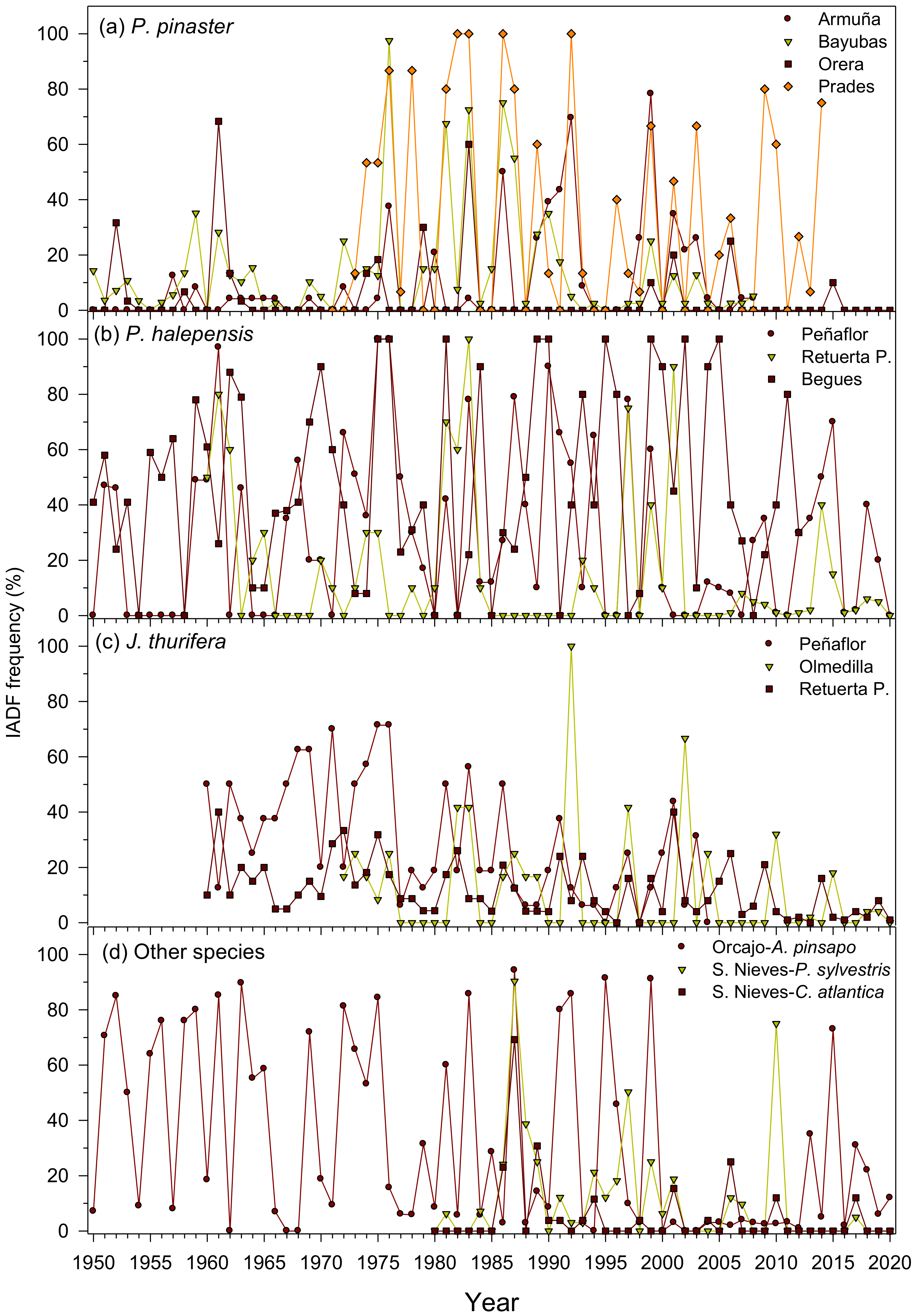
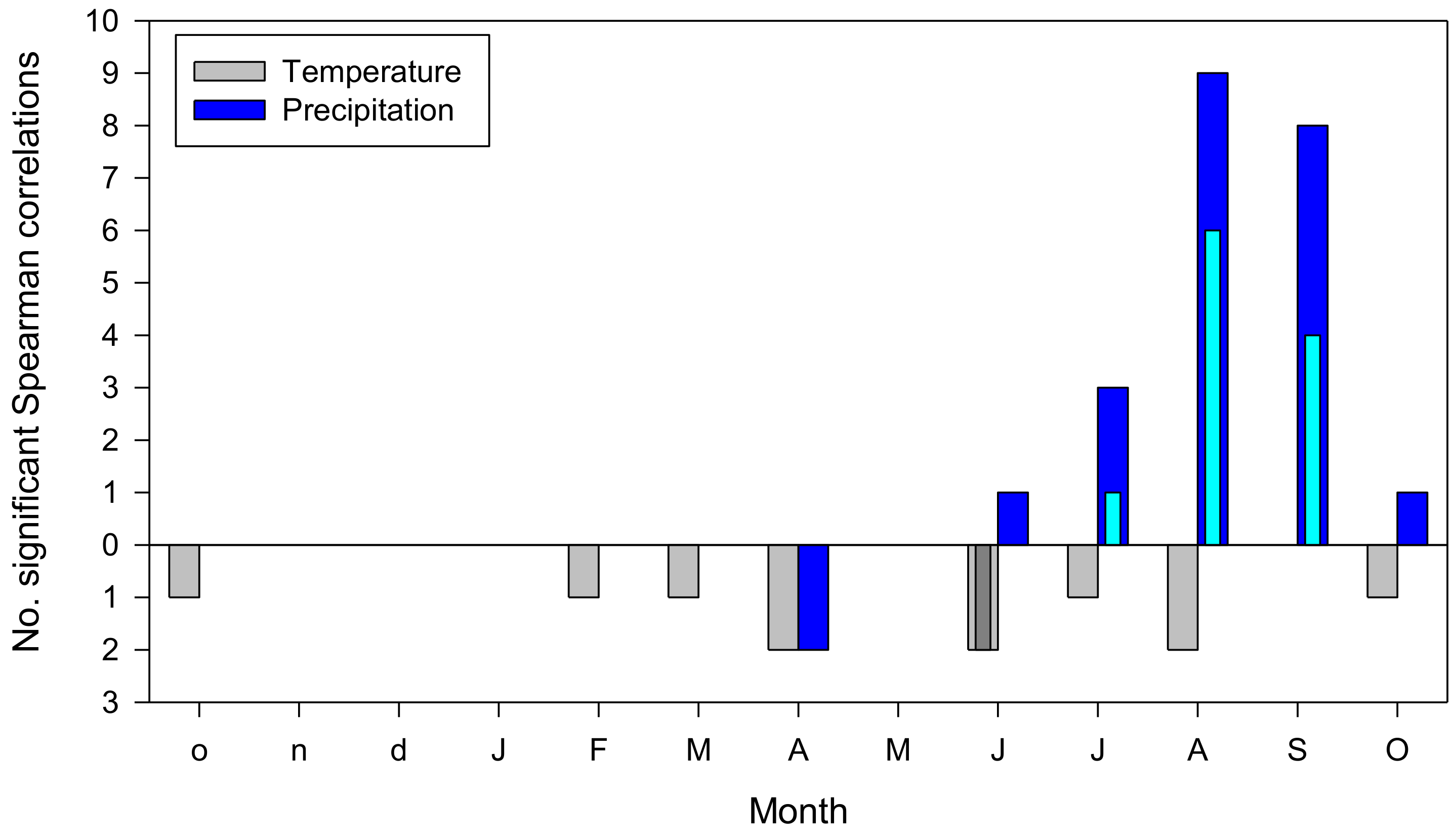
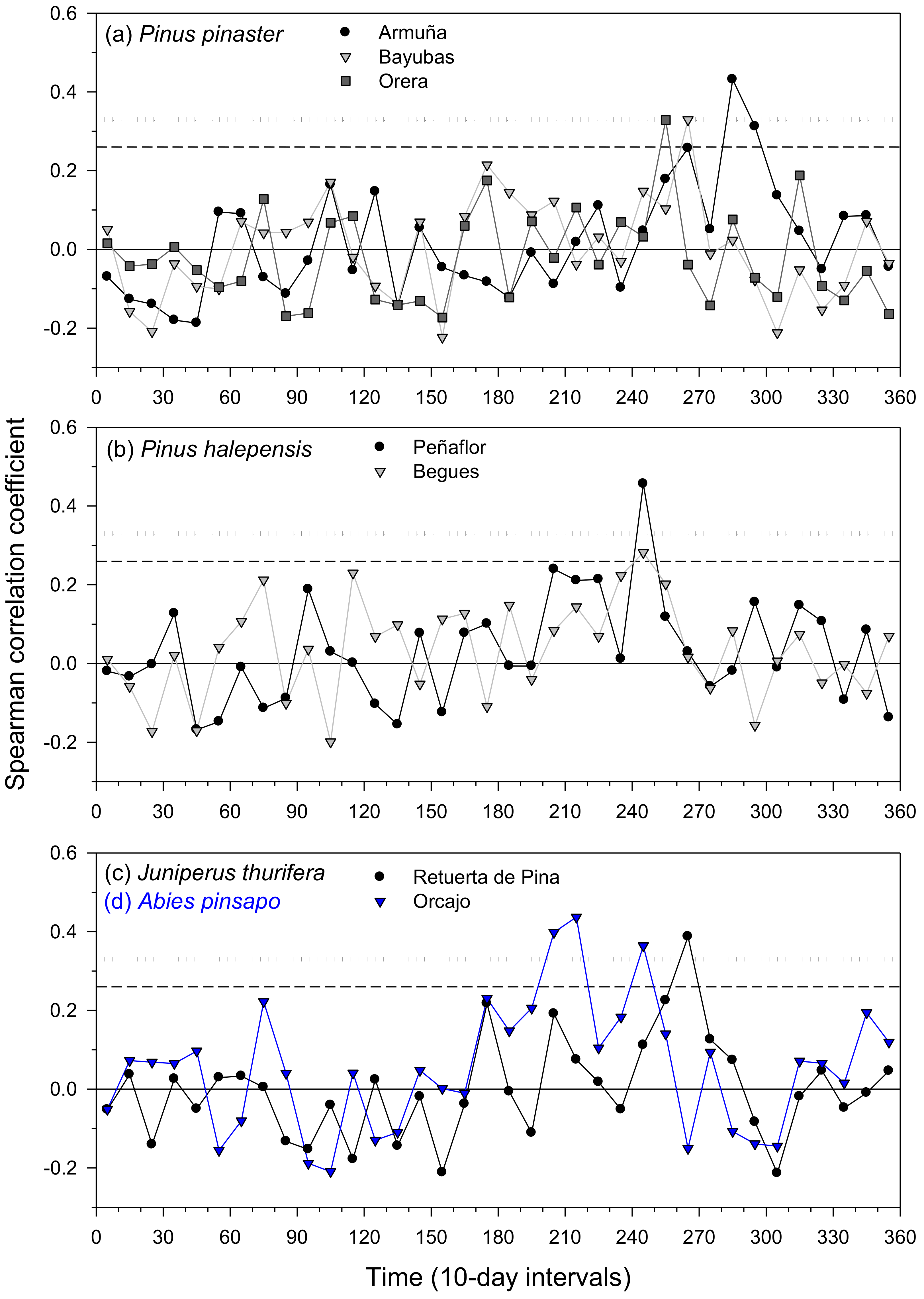
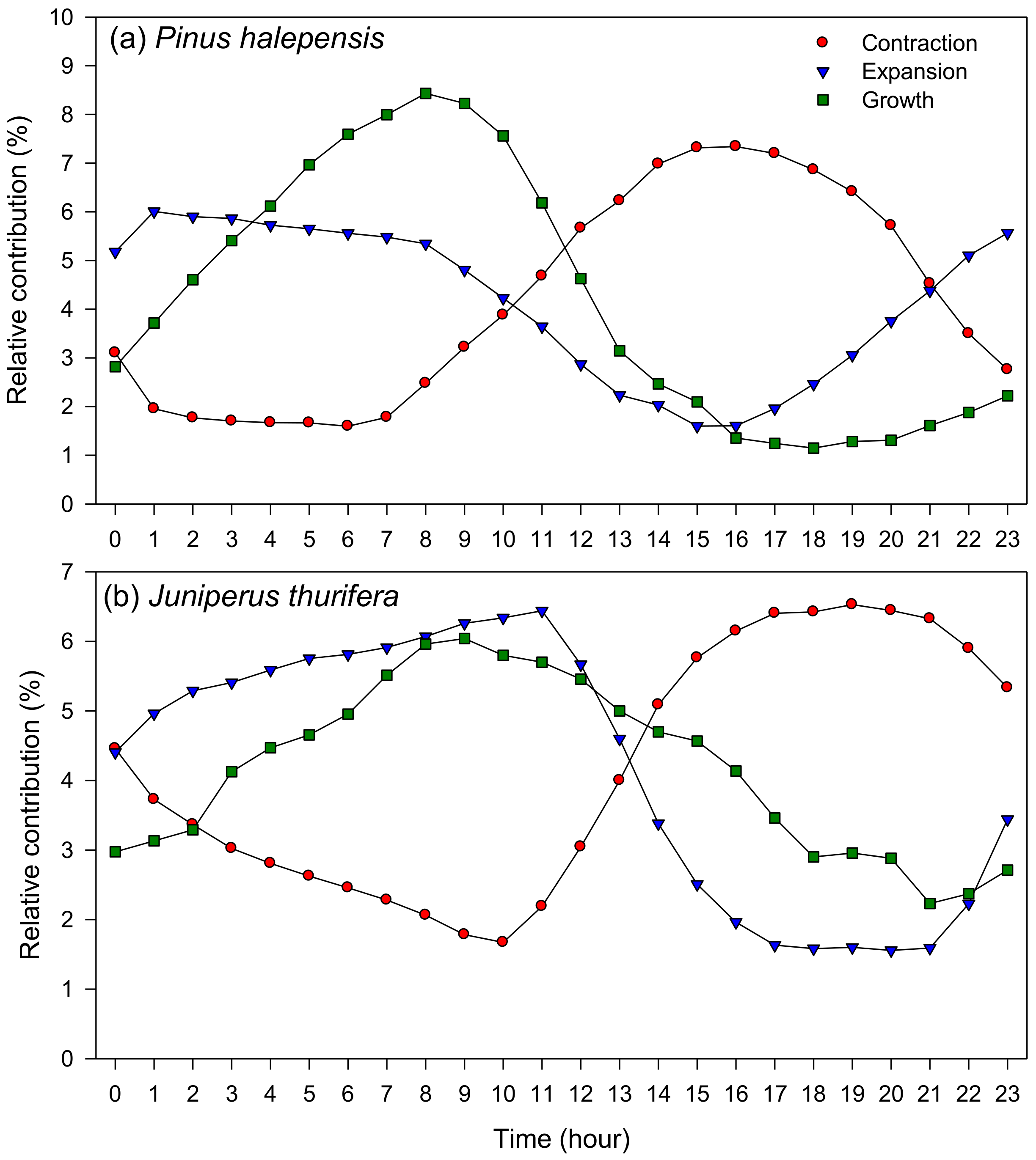
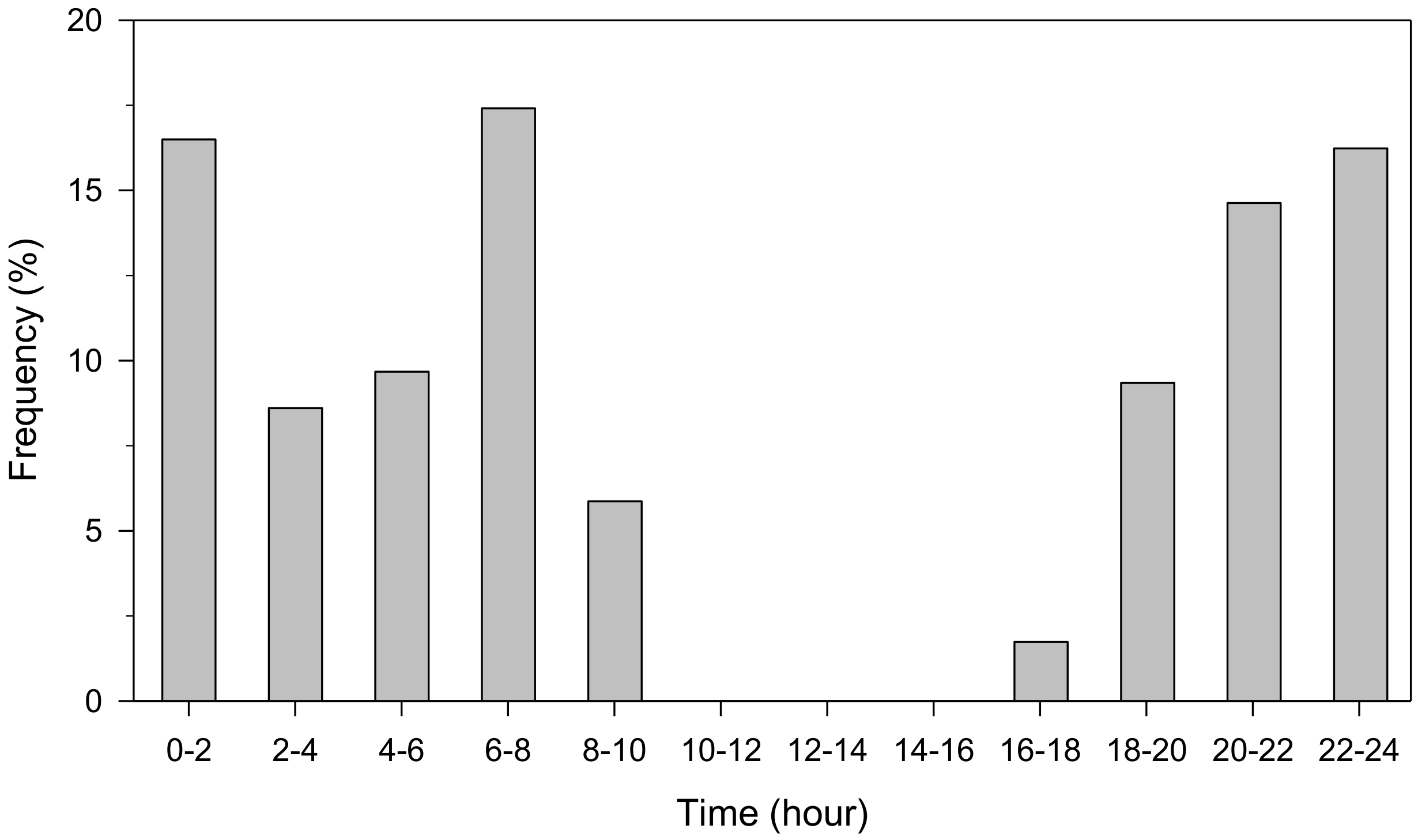
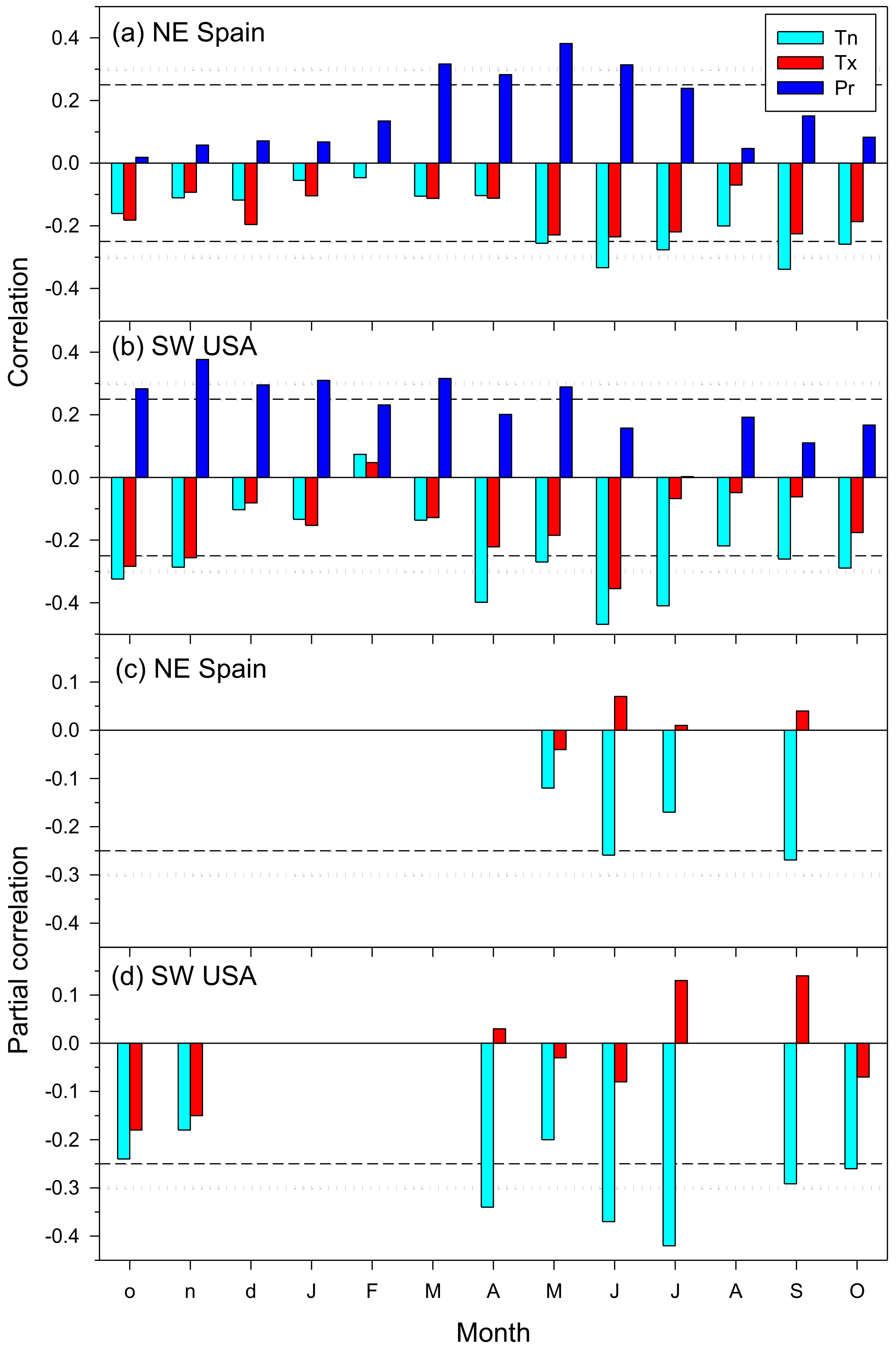
| Tree Species | Site | Latitude N | Longitude (−W, +E) | Elevation (m a.s.l.) | Mean Temperature (°C) | Annual Precipitation (mm) | Dbh (cm) |
|---|---|---|---|---|---|---|---|
| Pinus pinaster | Armuña | 41.08 | −4.31 | 870 | 11.6 | 488 | 41.0 ± 2.3 |
| Bayubas | 41.53 | −2.89 | 850 | 10.5 | 527 | 31.2 ± 1.1 | |
| Orera | 41.30 | −1.46 | 884 | 13.0 | 412 | 28.3 ± 0.9 | |
| Prades * | 41.34 | 1.04 | 807 | 11.8 | 659 | 24.2 ± 2.6 | |
| Pinus halepensis | Peñaflor | 41.78 | −0.71 | 350 | 13.9 | 356 | 32.3 ± 4.6 |
| Retuerta de Pina | 41.48 | −0.26 | 360 | 13.2 | 378 | 29.6 ± 2.8 | |
| Begues | 41.34 | 1.89 | 300 | 13.2 | 673 | 24.0 ± 0.8 | |
| Juniperus thurifera | Peñaflor | 41.78 | −0.71 | 345 | 13.9 | 356 | 17.5 ± 2.9 |
| Olmedilla | 40.29 | −0.74 | 1350 | 9.8 | 496 | 29.0 ± 2.0 | |
| Retuerta de Pina | 41.48 | −0.26 | 360 | 13.2 | 378 | 25.0 ± 1.5 | |
| Abies pinsapo | Orcajo * | 41.09 | −1.51 | 1152 | 11.5 | 612 | 36.0 ± 1.9 |
| Pinus sylvestris | Sierra de las Nieves * | 36.65 | −4.93 | 1400 | 10.8 | 1180 | 33.2 ± 1.5 |
| Cedrus atlantica | Sierra de las Nieves * | 36.65 | −4.93 | 1400 | 10.8 | 1180 | 32.0 ± 2.0 |
| Tree Species | Site | Age at 1.3 m (Years) | No. Trees/No. Radii | Tree-Ring Width ± SD (mm) | AR1 | MSx | IADF (%) | Best-Replicated Period |
|---|---|---|---|---|---|---|---|---|
| Pinus pinaster | Armuña | 88 ± 3 | 15/41 | 2.42 ± 1.28 | 0.68 | 0.29 | 45.8 | 1898–2008 |
| Bayubas | 92 ± 4 | 22/46 | 1.48 ± 0.88 | 0.77 | 0.28 | 79.7 | 1876–2008 | |
| Orera | 87 ± 3 | 33/66 | 1.24 ± 1.11 | 0.73 | 0.47 | 19.7 | 1920–2019 | |
| Prades | 46 ± 2 | 25/50 | 1.30 ± 0.89 | 0.71 | 0.52 | 83.6 | 1975–2020 | |
| Pinus halepensis | Peñaflor | 89 ± 3 | 26/52 | 0.94 ± 0.27 | 0.52 | 0.44 | 62.5 | 1906–2020 |
| Retuerta de Pina | 75 ± 2 | 32/47 | 1.11 ± 0.21 | 0.72 | 0.36 | 47.8 | 1939–2020 | |
| Begues | 87 ± 3 | 22/43 | 0.98 ± 0.25 | 0.76 | 0.28 | 88.3 | 1941–2019 | |
| Juniperus thurifera | Peñaflor | 71 ± 2 | 21/42 | 1.21 ± 0.87 | 0.62 | 0.41 | 72.0 | 1941–2020 |
| Olmedilla | 88 ± 3 | 27/54 | 0.97 ± 0.47 | 0.65 | 0.32 | 44.0 | 1949–2019 | |
| Retuerta de Pina | 69 ± 3 | 32/55 | 1.09 ± 0.43 | 0.58 | 0.35 | 78.0 | 1964–2019 | |
| Abies pinsapo | Orcajo | 51 ± 2 | 17/35 | 2.37 ± 1.12 | 0.54 | 0.37 | 87.5 | 1970–2019 |
| Pinus sylvestris | Sierra de las Nieves | 40 ± 1 | 20/39 | 4.08 ± 1.67 | 0.75 | 0.22 | 56.7 | 1983–2019 |
| Cedrus atlantica | Sierra de las Nieves | 37 ± 1 | 18/34 | 5.02 ± 1.25 | 0.56 | 0.22 | 36.7 | 1986–2019 |
| Tree Species | Site | Growth Rate | Age | |||
|---|---|---|---|---|---|---|
| rs | p | No. Rings | rs | p | ||
| Pinus pinaster | Armuña | 0.411 | <0.001 | 1123 | −0.381 | <0.001 |
| Bayubas | 0.383 | <0.001 | 1459 | −0.599 | <0.001 | |
| Orera | 0.453 | <0.001 | 2189 | −0.267 | 0.207 | |
| Prades | 0.351 | <0.001 | 820 | 0.152 | 0.521 | |
| Pinus halepensis | Peñaflor | 0.296 | <0.001 | 955 | −0.709 | 0.015 |
| Retuerta de Pina | 0.181 | <0.001 | 552 | −0.246 | 0.217 | |
| Begues | 0.130 | <0.001 | 1380 | −0.596 | 0.023 | |
| Juniperus thurifera | Peñaflor | 0.271 | <0.001 | 712 | −0.056 | 0.835 |
| Olmedilla | 0.158 | <0.001 | 748 | 0.320 | 0.338 | |
| Retuerta de Pina | 0.352 | <0.001 | 904 | −0.202 | 0.196 | |
| Abies pinsapo | Orcajo | 0.198 | <0.001 | 1708 | 0.275 | 0.210 |
| Pinus sylvestris | Sierra de las Nieves | 0.339 | <0.001 | 799 | 0.157 | 0.591 |
| Cedrus atlantica | Sierra de las Nieves | 0.141 | <0.001 | 691 | 0.241 | 0.223 |
Publisher’s Note: MDPI stays neutral with regard to jurisdictional claims in published maps and institutional affiliations. |
© 2022 by the author. Licensee MDPI, Basel, Switzerland. This article is an open access article distributed under the terms and conditions of the Creative Commons Attribution (CC BY) license (https://creativecommons.org/licenses/by/4.0/).
Share and Cite
Camarero, J.J. Why Intra-Annual Density Fluctuations Should Be Formed at Night? Implications for Climate–Growth Relationships in Seasonally Dry Conifer Forests. Forests 2022, 13, 1425. https://doi.org/10.3390/f13091425
Camarero JJ. Why Intra-Annual Density Fluctuations Should Be Formed at Night? Implications for Climate–Growth Relationships in Seasonally Dry Conifer Forests. Forests. 2022; 13(9):1425. https://doi.org/10.3390/f13091425
Chicago/Turabian StyleCamarero, Jesús Julio. 2022. "Why Intra-Annual Density Fluctuations Should Be Formed at Night? Implications for Climate–Growth Relationships in Seasonally Dry Conifer Forests" Forests 13, no. 9: 1425. https://doi.org/10.3390/f13091425






